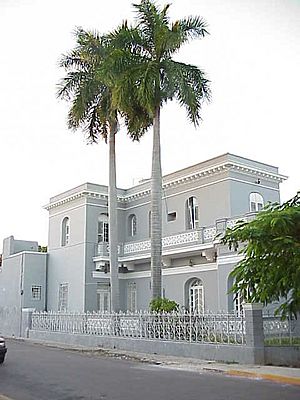Yagua facts for kids
Quick facts for kids Yagua |
|
|---|---|
 |
|
| Conservation status | |
| Scientific classification | |
| Genus: |
Roystonea
|
| Species: |
dunlapiana
|
Roystonea dunlapiana, also called yagua or cabiche, is a type of palm tree. It grows naturally in Nicaragua, Honduras, and parts of southern Mexico. These Mexican states include Chiapas, Campeche, Quintana Roo, Tabasco, and Veracruz. This palm is special because it's the only Roystonea palm not found on the Caribbean islands.
Contents
About the Yagua Palm
The Roystonea dunlapiana is a very tall palm tree. It can grow up to 20 metres (66 ft) high. Its main stem, called the trunk, is grey-white. It measures about 38 centimetres (15 in) across.
The top part of the trunk has a smooth, green section. This part is made of tightly wrapped leaf bases. It is called a crownshaft and is about 2 m (6.6 ft) long. The tree usually has about 15 large leaves. Each leaf has a strong central stem, called a rachis, which is about 4-metre (13 ft) long. These leaves spread out almost flat.
The tree produces flower clusters, known as inflorescences. These are about 1 m (3.3 ft) long. They have white male flowers with purplish parts called anthers. The female flowers have not been fully described yet. When the fruit ripens, it turns purplish-black. The fruit is usually 12–14.7 millimetres (0.47–0.58 in) long and 7.1–9.5 mm (0.28–0.37 in) wide.
How We Classify This Palm
Scientists group Roystonea palms into a larger family called Arecoideae. They are also part of a smaller group called the tribe Roystoneeae.
The exact place of Roystonea within the Arecoideae family is still being studied. Scientists use plastid DNA to understand how plants are related. However, this method has not fully shown where Roystonea fits. As of 2008, more studies are needed to understand how R. dunlapiana is related to other Roystonea palms.
An American plant expert named Paul H. Allen first described this palm in 1952. His description of R. dunlapiana was important. It was the first time Roystonea palms were officially recorded as growing in Central America. He also described another palm, R. regia var. hondurensis, which is now considered the same as the common R. regia.
Common Names
In Honduras, this palm is often called yagua or cabiche.
Where the Yagua Palm Grows
The Roystonea dunlapiana palm is found naturally in southern Mexico, Honduras, and Nicaragua. A scientist named Scott Zona, who studied these palms, believed it might also grow in Belize.
This palm prefers to grow in wet areas. You can often find it in estuaries, which are places where rivers meet the sea. It also grows in coastal swamps. It is unique because it is the only Roystonea palm species that does not grow on the islands of the Caribbean.
See also
 In Spanish: Roystonea dunlapiana para niños
In Spanish: Roystonea dunlapiana para niños


